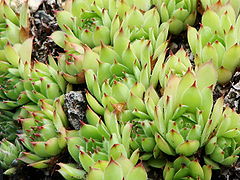Sempervivum tectorum
| Habit | herbaceous
| |
|---|---|---|
| Height: | ⇕ | 3 in"in" can not be assigned to a declared number type with value 3. to 4 in"in" can not be assigned to a declared number type with value 4. |
| Width: | ⇔ | 8 in"in" can not be assigned to a declared number type with value 8. |
| Lifespan: | ⌛ | perennial |
| Bloom: | ❀ | early summer, mid summer, late summer |
| Exposure: | ☼ | sun |
|---|---|---|
| Features: | ✓ | flowers |
| USDA Zones: | 5 to 9 | |
| Flower features: | ❀ | blue, purple |
|
tectorum > |
Sempervivum tectorum (Common Houseleek[1]) is a perennial plant of the genus Sempervivum. It is used as an ornamental plant. It is also known as Hen and chicks,[2] although that name is shared with a variety of related species. It has Leaves in a basal rosette, they are succulent and can be green, red, purple or yellow. The leaves are evergreen.
The flowers can be purple,red or pink depending on the cultivar. They appear on branched stalks.
Read about Sempervivum tectorum in the Standard Cyclopedia of Horticulture
|
|---|
|
Sempervivum tectorum, Linn. (S. robustum, Jord. & Fourr. S. purpurascens, Schott). Houseleek. Old-man-and-woman. Fig. 3602. Developed barren rosettes 3-4 in. diam., abundantly stoloniferous, the new rosettes crowded and sessile: lvs. 50-60 to a rosette, obovate-cuneate, cuspidate, 1 1/2 – 2 or finally 3 x 5/8-3/4 in., pale green, with a distinct red-brown tip; cauline lvs. oblong-lanceolate, acute: fl.-st. including infl. about 1 ft. high, densely pilose: fls. 11-15- mostly 12-merous, 3/4-l in. across, pale red, in a scorpioid, 10-12-branched panicle 5-6 x 3-4 in.; calyx densely pilose, segms. lanceolate; petals linear, keeled, the keel deeper red. Eu. and Orient. C.L.A. 25, March, p. 54.—Variable. Var. cupreum, Hort., is said to have large rosettes which are glaucous and rose-colored; it flowers rarely. Var. expansum, Hort., is said to have broader lvs. and more open rosettes than the type. Var. pyrenaicum, Hort., is offered in the trade. Var. rubrum, Hort., has been grown in botanic gardens. Var. violaceum, Hort., has been grown in botanic gardens.
|
Cultivation
Propagation
Pests and diseases
Varieties
Gallery
References
- Standard Cyclopedia of Horticulture, by L. H. Bailey, MacMillan Co., 1963
External links
- w:Sempervivum tectorum. Some of the material on this page may be from Wikipedia, under the Creative Commons license.
- Sempervivum tectorum QR Code (Size 50, 100, 200, 500)




